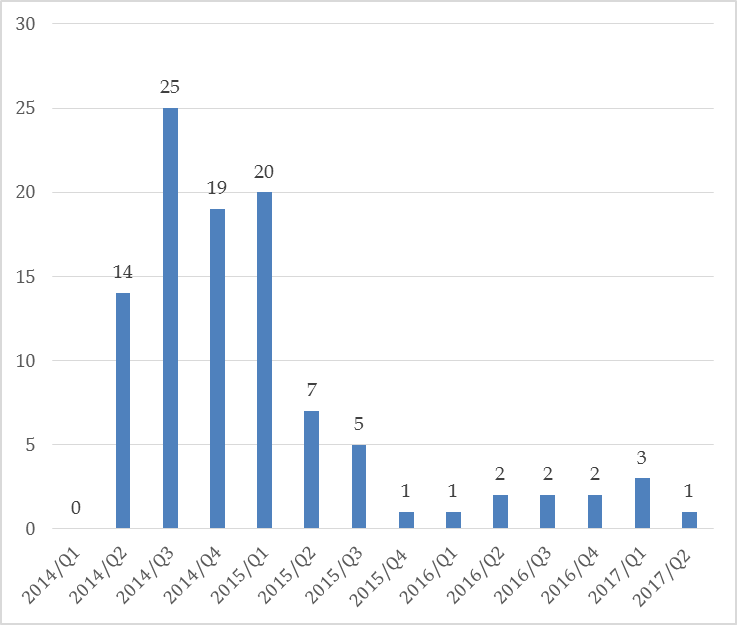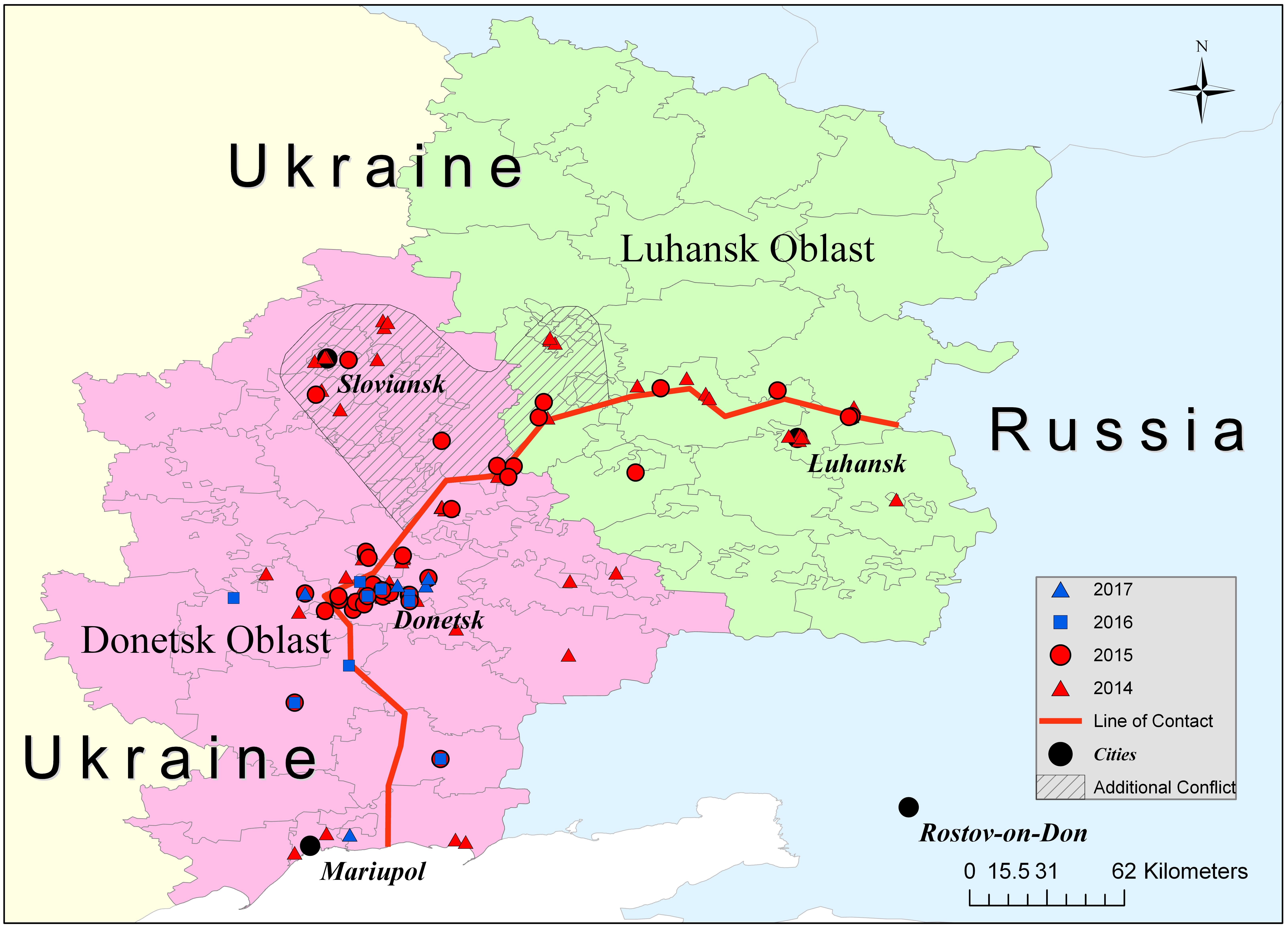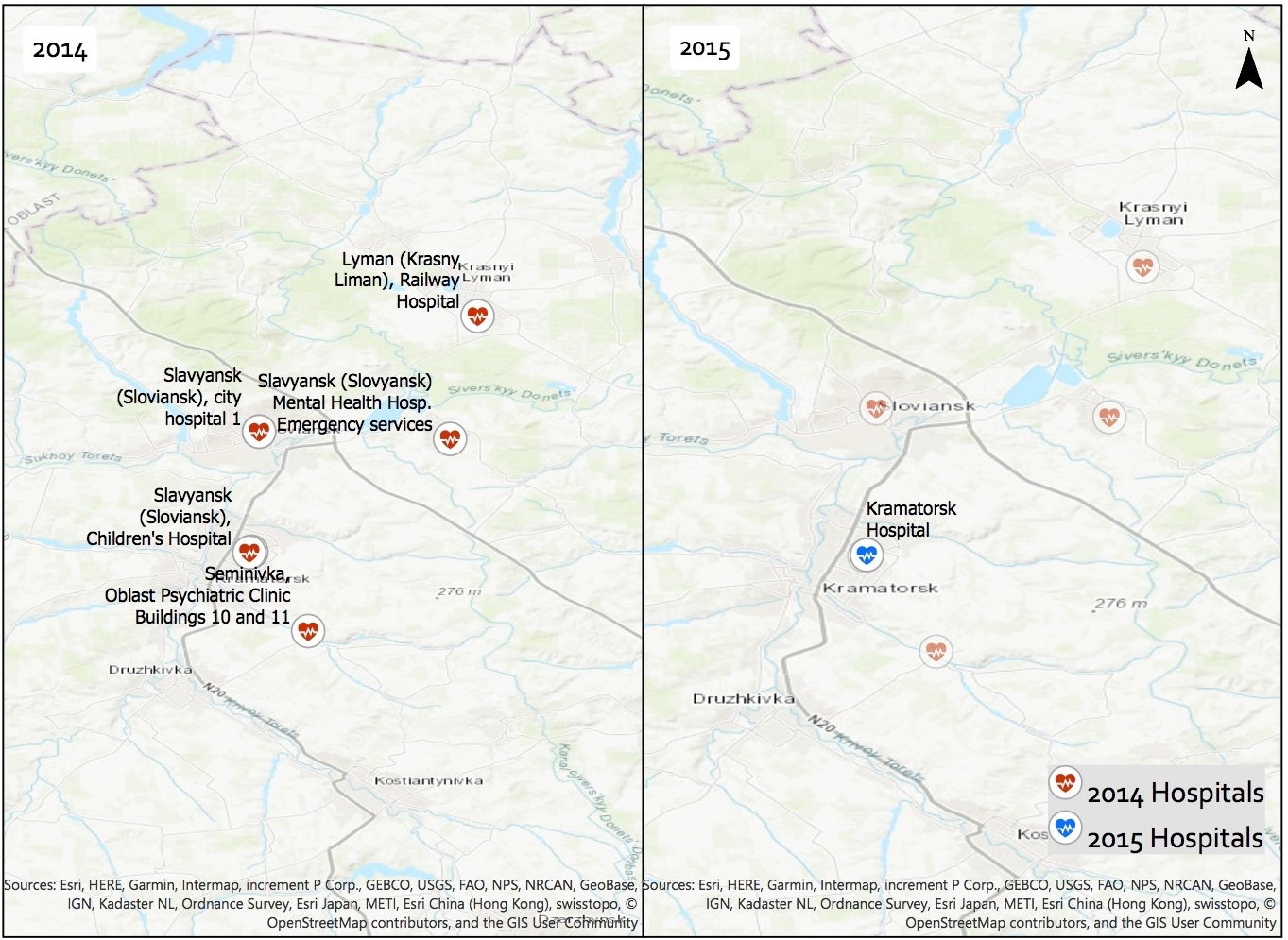(PONARS Eurasia Policy Memo) Since the armed conflict in the Donbas region of eastern Ukraine began in early 2014, over 10,000 lives have been lost and nearly two million persons displaced, making this one of the world’s largest humanitarian crises. The considerable damage wrought to the infrastructure, especially healthcare facilities, of what had been one of Europe’s major urban-industrial areas and home to some 6.6 million people, remains underappreciated. Damage to healthcare infrastructure has exerted a severely negative impact on quality of life in the conflict zone and beyond with implications for the legitimacy of the Ukrainian state. Destruction of humanitarian infrastructure goes against international agreements concerning armed engagements, and it diminishes the provision of public goods in the short term and creates long-term challenges for rebuilding state legitimacy in the long term, which is critical for geopolitical stability in this hitherto fraught territory.
The UN’s World Health Organization (WHO), which is charged with tracking attacks on hospitals and clinics in conflict zones globally, notes that there is a significant knowledge gap on the subject. We address this gap by adducing a geospatial event data set of attacks on medical facilities in the Donbas. Our preliminary analysis, previously reported in the Washington Post’s Monkey Cage blog, generally discussed the scale and location of damage. In this memo, we present an updated and more refined analysis of our data and update other estimates (especially those by the WHO). Among our main findings is that healthcare infrastructure and consequently the well-being of people living in the Donbas have experienced substantial degradation with at least one-third of the large care facilities damaged by combat. Given this, we offer several recommendations to international policymakers as they evaluate how to respond to the war.
A Real and Not a “Hybrid” War
Russia’s relatively non-violent seizure of the Ukrainian region of Crimea in early 2014 served to popularize the notion of “hybrid warfare” (although the term antedates the Crimean crisis). Hybrid warfare is generally considered a largely surreptitious operation employing commandos, intelligence operatives, local anti-government militants, and sophisticated media and disinformation campaigns. Accordingly, when civil unrest directed against the Kyiv government spread to eastern Ukraine, with its large ethnic Russian or Russophone population, it was viewed by some as part and parcel of this Moscow-directed non-kinetic operation against Ukraine by means short of war. Once the Ukrainian government made clear in mid-April 2014 that it intended to suppress this unrest and quash secessionist movements and took military steps to do so (itself avoiding the term “war,” referring instead to an “anti-terrorist operation” or ATO), the intensity of fighting increased steadily.
Violence escalated through the spring and summer of 2014 until clearly major armed combat was underway involving artillery, armor, and eventually actual units of the Russian army with sophisticated electronic warfare and surveillance capability. Thus, what resulted from this escalation in the fighting became anything but hybrid warfare or an ATO but rather modern warfare with all of the consequences—heavy casualties and large-scale physical damage—implied by the use of advanced weaponry on a large scale by both sides. As CNA analyst Michael Kofman explains, this is in keeping with the “[i]nterplay between irregular forces, proxies, and conventional military power…” that has become Russia’s operational modus operandi.
After the ATO made considerable headway, and separatist fighters were forced to retreat into pockets around the cities of Donetsk and Luhansk, regular units of the Russian army attacked Ukrainian troops across the border, entering Ukraine proper to augment the remnants of the irregular forces in a counteroffensive all along the front from the Sea of Azov in the south through the Donetsk region and into the Luhansk region in the northeast. By the end of February 2015, the battlefront stabilized after especially bloody fighting near Ilovaisk and Debaltseve and has since then remained static under the provisions of the Minsk II agreement along the so-called “line of contact.”
Despite the putative ceasefire monitored by the Organization for Security and Co-operation in Europe (OSCE), there have been innumerable violations along the front, including massed artillery and rocket fire and infantry skirmishes, with the result that the casualty list and damage to infrastructure continue to grow. It is important to underscore that the use of indirect “area effects” weapons such as multiple rocket launchers and heavy artillery by both sides in the conflict has contributed to civilian infrastructure damage. These “area effects” weapons are largely indiscriminate (not precision-guided) and thus are likely to cause collateral damage to other-than-military targets and result in civilian causalities.
Very Real Consequences for Healthcare and Health
The damage described above includes well documented instances of direct fire against healthcare facilities from tanks and other armored vehicles or anti-tank missiles, most often when opposing troops have occupied those buildings. We do not address here intention or the means for attacks on hospitals and clinics. Instead, we show that the damage has been devastating beyond what was generally known.
Mapping precise infrastructural impacts of military engagement in the region is challenging due to limited access to the conflict zone, safety concerns for observers and journalists, the highly politicized nature of regional press reports, and the prevalence of reports of general shelling that lack specific information on precise points of contact. Prompted by findings from Syria and multiple anecdotal reports collected from individuals internally displaced from the region, we conducted a systematic review[1] of press reports concerning healthcare sites and shelling in the Donbas.[2] Employing keyword searches,[3] we created a report database of mappable healthcare infrastructure damage by quarter of occurrence, source, and where clear, attribution. Results were checked against local listings and addresses, geo-coded, and mapped.
We recorded reports of damage to healthcare infrastructure in the same calendar quarter as one occurrence, to avoid dual reporting, generating a conservative estimate of the total number of locations damaged. We excluded reports citing general damage without reference to a name or location or listings for unverifiable locations.[4] Many locations (23) reported damage across multiple quarters and some, such as Hospital Number 1 in the city of Donetsk, were subject to multiple attacks. Coverage was not universal across sources, with 76 percent of damaged locations (typically those damaged in only one quarter) reported by only one source.
We found that over one-third (102) of the hospitals and clinics in our Donbas regional database had been damaged or destroyed from early 2014 through 2017, with over three-quarters of those attacks occurring during the period of heaviest fighting (the third quarter and fourth quarters of 2014 and the first quarter of 2015 (see Figure 1)).
Figure 1: Quarterly Individual Shelling Reports for Specific Donbas Hospitals, 2014-2017

These numbers accord well with estimates by the WHO, which, in a report from August 2016, estimated that 145 hospitals had been shelled, and in a later report from December 2016, reported that 150 of 342 healthcare facilities within the conflict zone itself were attacked since the beginning of the conflict. We believe that the differences in the number of incidents are attributable to varying definitions of what constitutes a “healthcare facility” and the criteria used for separating events; the WHO has many more (614) healthcare facilities listed in the Donetsk and Luhansk regions than we have in our database, probably because they have included small or temporary aid stations that they are able to identify because of their presence on the ground, whereas we have inventoried permanent facilities only.
Location Matters
Because our database is geospatially coded, we are able to pinpoint the location of damaged or destroyed facilities (see Figure 2) and relate these incidents to the ebb and flow of fighting across the region. The first and most obvious point is that the greatest damage has occurred in areas where the fighting has been most intense—that is, along the so-called “line of contact” dividing Ukrainian government-held territory and that occupied by pro-Russian separatists, especially in the area around the city of Donetsk and its environs (including Horlivka and Avdiivka).
Figure 2: Reported Hospital Attacks in Eastern Ukraine, 2014-2017

Secondly, there are a number of events clustered around Sloviansk, including Kramatorsk and Lyman and further east to Lysychansk, where the ATO pushed the separatists back amid very heavy urban fighting (see Figure 3 for a more detailed look). Finally, of note is the smaller cluster of attacks along the northern coast of the Sea of Azov resulting from the Russian offensive toward Mariupol in August 2014.
Figure 3: Sloviansk Area Hospital Attacks, 2014-2015

In sum, healthcare infrastructure in the Donbas region has experienced significant degradation, with one-third or more of the large care facilities damaged as the result of combat operations. The widespread use of “area effect” weapons, and the lack of precision weapons typically used by attack aircraft (which have not figured prominently in this conflict), indicate that healthcare facilities have likely experienced collateral damage. When they have been targeted, evidence suggests that the neutrality of these facilities has been compromised by the presence of quartered combatants. The consequences of healthcare damage on the civilian population are significant; in many cases, the facilities that have been compromised provide the only accessible healthcare to local residents.
Providing Healthcare and the Legitimacy Challenge
Why should policymakers care about the largely “unintended” collateral effects of the Donbas war on medical facilities if they have not been the primary targets of combatants? Should not policymakers emphasize efforts to defend and deter purposeful attacks, and training and tactics employed by both sides more broadly, rather than debating the transfer of advanced weaponry to Ukraine’s military? While security concerns are critical, we argue that focusing on kinetic operations alone fails to inform threats to longer-term stability in the region.
Ukrainian citizens identify the Donbas war as the most acute problem the country faces, but social and economic issues follow closely behind. In a September 2018 survey by the Kyiv International Institute of Sociology (KIIS), respondents expressed worries about income, housing, inflation, corruption, social services, and inadequate healthcare. A few months earlier, in July 2018, KIIS fielded a survey about health and wellbeing, noting that the main determinants of perceptions of wellbeing were the objective provision of services and perceptions built upon media reports. In the area of healthcare, Ukraine’s services have been negatively affected by the failure to enact important reforms since the Soviet collapse. As Virginia Commonwealth University professor Judyth Twygg wrote last year, “Twenty-six years after independence, [the healthcare sector] still prioritizes curative services over prevention, hospitals over ambulatory services, and specialists over primary care… Incentives promoting quality—or put another way, attention to health outcomes—are virtually absent.”
Reforms have been impeded by structural resistance, but also information operations designed to link negative health outcomes with broader efforts to advance cooperation with Western European institutions. The provision of healthcare, where citizen satisfaction is linked both with objective service provision and perceptions, is part of a broader class of government services, referred to as state capacity, that demonstrate its ability to function effectively and earn citizen support.
While societies may vary in the degree to which these services are provided by the private sector or state, the state typically provides a baseline. As demonstrated by University of Tokyo professor Kimitaka Matsuzato, in the key eastern Ukrainian conflict zone cities of Mariupol and Kramatorsk, oligarchic industrial firms provided essential public services, and the control of local politics was very much intertwined with municipal functions and the mitigation of damage incurred during fighting in those areas. That said, the state is usually held accountable when those services are disrupted. A proactive approach such as that taken in Estonia with its large ethnic Russian minority might mitigate citizen alienation or foster good will toward the state. Georgia, for another example, is currently seeking to expand healthcare provision for residents of Abkhazia and South Ossetia that are “frozen conflict” separatist regions.
Ukraine faces a dual threat from the Donbas war in terms of the link between state capacity and legitimacy. The conflict has degraded the delivery of state services because of damage to civilian infrastructure, as illustrated by the data on Donbas healthcare facilities. Also, the perception that the state is attending to citizens’ needs, especially inasmuch as citizens are taxed to provide the wherewithal to do so, may be undermined by information operations designed to enhance perceptions that Ukraine is unable—or unwilling—to assist those living near the line of contact. More generally, the impact of much needed proposed reforms in the healthcare sector to curtail widespread corruption and “pay-to-play” medical services remains an open question. In the long term, this raises serious challenges to capacity regardless of who controls the disputed areas. If the Ukrainian experiment in sovereign statehood is to succeed, citizens must believe that government authority is legitimate. The Ukrainian government, in turn, must credibly demonstrate that it provides essential services such as healthcare in the areas that it controls, and might find that it would gain geopolitical advantage by facilitating care to those on the other side of the line of contact.
Recommendations
As international policymakers evaluate how to respond to the Donbas war, we offer several recommendations:
► Acknowledge that the conflict has evolved from hybrid war into full-scale combat operations.
► Press all sides of the conflict to avoid using hospitals to shelter combatants or take actions that turn civilian infrastructure into targets.
► Commit humanitarian aid to both sides of the line of conflict that can assist with the provision of essential services like healthcare, including to non-combatants who cross the frontline seeking aid or treatment without adjudicating their status.
► Assist in efforts to modernize service provision to citizens, especially in healthcare.
► Develop robust information operations to counter messaging that undermines legitimacy.
Erik S. Herron is the Eberly Family Professor of Political Science at West Virginia University.
Ralph S. Clem is Professor Emeritus of Geography and Senior Fellow at the Steven J. Green School of International and Public Affairs at Florida International University.
Cynthia J. Buckley is Professor of Sociology at the University of Illinois, Urbana-Champaign.
The authors wish to thank Jarod Fox and the Slavic Reference Service of the University of Illinois for their research assistance.
PDF | Pepm562_Herron-Clem-Buckley_Jan2019.pdf
[1] We utilized the EastView newspaper database through the Slavic Reference Service of the University of Illinois.
[2] Including all central newspapers in Ukraine (2014- mid-2018), the Russian Federation (2014- mid-2018), ten papers in the Donbas itself (2014-2015), quarterly reports by the Office of the United Nations High Commissioner for Human Rights (OHCHR), non-governmental organization (NGO) reports, and searches of major international English-language news sources such as The New York Times, The Washington Post, The Guardian, The Financial Times, and The Chicago Tribune.
[3] We searched for the terms “healthcare, “ “hospital, “ “clinic,” “shelling,” “damage,” “destruction,” “hostilities,” “Donbas,” “Luhansk,” and “Donetsk” in all combinations in Ukrainian, Russian, and English.
[4] We recorded 136 general reports of damage to healthcare infrastructure and 39 reports of damage to an unverifiable healthcare facility.











